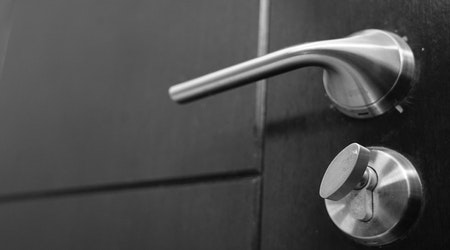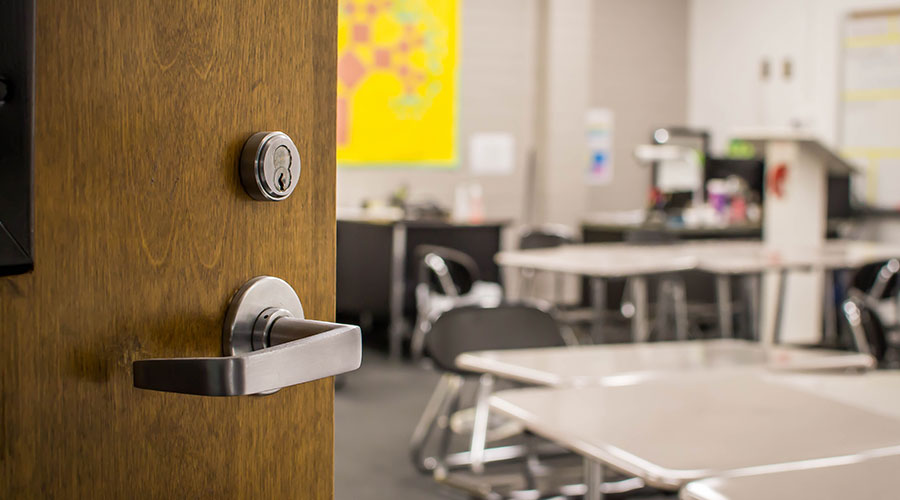Door Hardware: Code Considerations
Tracking the constant changes in codes and standards ensures facilities remain safe and accessible
Successful specification of door hardware components requires that maintenance managers understand the way occupants and visitors enter and move through buildings. Managers also need to understand the way that outside issues, such as evolving security concerns, affect product decisions.
Perhaps the most important issue in the process, however, is monitoring the many applicable codes and standards that govern door hardware products. Specifying appropriate hardware starts with understanding common challenges related to codes and standards, but managers will be most successful by staying abreast of the constant changes that governing organizations make to these guidelines.
Assessing Priorities
Codes vary among states and municipalities, so local, state and federal codes might not agree. Added to the traditional concerns of many engineers and maintenance managers is the growing complexity of specifications and the need to ensure they follow all applicable codes and standards.
Beyond the top priority compliance issues — access, safety and security — failure to comply remains all too common. It can cause not only legal problems but also soaring insurance rates. The best way to ensure compliance is to be aware of codes and standards and their revisions.
Compliance issues are only getting more complex and demanding. For example, one door hardware specification for a California project refers to nine different codes, with the qualifier that, in the event of conflict, the stricter code applies.
Code Issues
Among the national standards and codes that managers must be aware of in specifying door hardware are those from the National Fire Protection Association (NFPA) and the American National Standards Institute/International Code Council (ANSI/ICC). Also, following the Americans with Disabilities Act access guidelines (ADAAG) is essential for success.
NFPA. NFPA 80 codifies and references standards for fire doors and fire windows, while NFPA 101 covers Life Safety Code and is titled Safety to Life in Buildings and Structures. Key provisions include having locks and hardware that provide free escape in an emergency, notwithstanding the need for security from unauthorized access. It also requires clear exit markings and door hardware that allows the door to swing in an unrestricted manner from any direction of egress. Evacuation signals also must be both visible and audible.
ICC and ANSI. The Louisiana state legislature has adopted ICC codes for rebuilding hurricane-damaged property. ICC codes will apply to all buildings built or rebuilt in the state after 2007. Florida’s building code is also based on the ICC codes. ANSI/ICC A117.1 is titled American National Standard for Accessible and Usable Buildings and Facilities. ICC code development for the revised 2006 version is following an 18-month process.
ICC codes are based on the application of standards, such as those from ANSI, and are specific to the need. For example, Gulf Coast construction must be able to withstand winds of 130-150 miles per hour. Codes also specify how the materials are constructed, as well as how they are tested, installed, and maintained.
ADAAG. Access Guidelines for Buildings and Facilities, Section 4, is labeled “Accessible Elements and Spaces.” Section 4.13 related to doors and gives guidelines for doors in order to be considered accessible.
These guidelines, besides setting minimum door clearances and threshold-height limits above the floor, define accessible door hardware. Handles, pulls, latches, locks and other operating devices must be shaped for easy grasping with one hand.
No tight pinching, grasping, or twisting of the wrist is allowed, and operation should require no more than 5 pounds of force. Lever handles, push/pull, or U-shaped handles generally comply with the guidelines, but some cylindrical knob handles do not.
Keeping up with Change
The main sources for information about changes in codes and standards are the official publications of the governing organizations involved. Their standards are available in hard copy and electronic formats. Managers can obtain them from reference libraries or purchase them by mail, phone or online from the web sites.
ICC publishes a calendar of events stating the date for each code revision step, and it posts updates on its progress at www.iccsafe.org. For more resources, see the article below.
Many manufacturers and distributors also list code references on their web sites, along with specification sheets and instructions installation, operation, and maintenance.
Many of these web sites also contain specification guidelines that can guide managers developing complete and accurate specifications. The guidelines walk specifiers through the various sections following a standard format, such as the Construction Specification Institute master format.
Under this format, hardware is listed in Section 08700, and door hardware is sub-section 08710. Using this format, managers can ensure that they include all parts of the specification and that they refer to proper codes and standards.
Door Hardware DATA
For up-to-date information on door hardware specification, installation and maintenance, check out these organizations:
-
American Hardware Manufacturers Association, (847)-605-1025, www.ahma.org
-
American National Standards Institute, (202) 293-8020, www.ansi.org
-
American Society for Industrial Security, (703) 519-6300, www.asisonline.org
-
Associated Locksmiths of America, (217) 819-9733, www.aloa.org
-
Builders Hardware Manufacturers Association, (800) 699-9277, www.buildershardware.com
-
Construction Specifications Institute, (800) 689-2900, www.csinet.org
- Door Hardware Institute, (703) 222-2010, www.dhi.org
-
International Code Council, (888) ICC-SAFE (422-7233), www.iccsafe.org
-
Maintenance Manager’s Standard Manual, Thomas A. Westerkamp, www.pninc.com
-
National Burglar and Fire Alarm Association, (888) 447-1689, www.alarm.org
- National Fire Protection Association, (617) 770-3000, www.nfpa.org
-
National Institute of Building Sciences, (202) 289-7800, www.nibs.org
-
Window and Door Manufacturers Association, (800) 223-2301, www.wdma.com
|
Related Topics:












